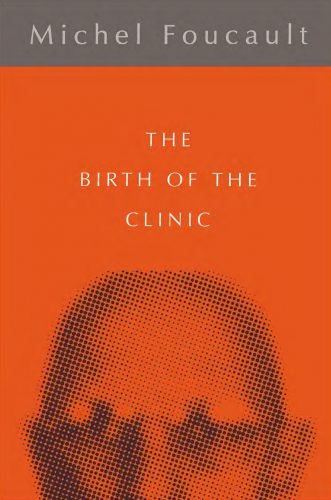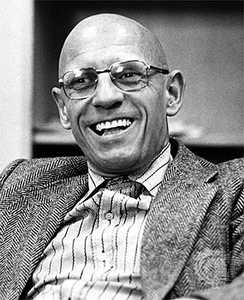The Birth of the Clinic by Michel Foucault

The Birth of the Clinic
Developing the themes explored in his previous work, Madness and Civilization, Foucault traces the development of the medical profession, and specifically the institution of the clinique (translated as “clinic”, but here largely referring to teaching hospitals). Its central points are the concept of the medical regard (“medical gaze”) and the sudden re-organisation of knowledge at the end of the 18th century, which would be expanded in his next major work, The Order of Things.
Book Details
Author: Michel Foucault
Print Length: 238
Publisher: Routledge
Original source: https://monoskop.org/images/9/92/Foucault_Michel_The_Birth_of_the_Clinic_1976.pdf
Submitted by: Robert
Book format: Pdf
Language: English
Book Download
Contents
- Preface
- Spaces and Classes
- A Political Consciousness
- The Free Field
- The Old Age of the Clinic
- The Lesson of the Hospitals
- Signs and Cases
- Seeing and Knowing
- Open Up a Few Corpses
- The Visible Invisible
- Crisis in Fevers
- Conclusion
Sample
The Birth of the Clinic
This book is about space, about language, and about death; it is about the act of seeing, the gaze.
Towards the middle of the eighteenth century, Pomme treated and cured a hysteric by making her take ‘baths, ten or twelve hours a day, for ten whole months’. At the end of this treatment for the desiccation of the nervous system and the heat that sustained it, Pomme saw ‘membranous tissues like pieces of damp parchment …peel away with some slight discomfort, and these were passed daily with the urine; the right ureter also peeled away and came out whole in the same way’. The same thing occurred with the intestines, which at another stage, ‘peeled off their internal tunics, which we saw emerge from the rectum. The oesophagus, the arterial trachea, and the tongue also peeled in due course; and the patient had rejected different pieces either by vomiting or by expectoration’ [1].
Less than a hundred years later, this is how a doctor observed an anatomical lesion of the brain and its enveloping membranes, die so-called ‘false membranes’ frequently found on patients suffering from ‘chronic meningitis:’
Their outer surface, which is next to the arachnoidian layer of the dura mater, adheres to this layer, sometimes very lightly, when they can be separated easily, sometimes very firmly and tightly, in which case it can be very difficult to detach them. Their internal surface is only contiguous with the arachnoid, and is in no way joined to it … The false membranes are often transparent, especially when they are very thin; but usually they are white, grey, or red in colour, and occasionally, yellow, brown, or black. This matter often displays different shades in different parts of the same membrane. The thickness of these accidental productions varies greatly; sometimes they are so tenuous that they might be compared to a spider’s web The organization of the false membranes also displays a great many differences: the thin ones are buffy, like the albuminous skins of eggs, and have no distinctive structure of their own. Others, on one of their sides, often display traces of blood vessels crossing over one another in different directions and injected. They can often be reduced to layers placed one upon another, between which discoloured blood clots are frequently interposed [2].
Between Pomme, who carried the old myths of nervous pathology to their ultimate form, and Bayle, who described the encephalic lesions of general paralysis for an era from which we have not yet emerged, the difference is both tiny and total. For us, it is total, because each of Bayle’s words, with its qualitative precision, directs our gaze into a world of constant visibility, while Pomme, lacking any perceptual base, speaks to us in the language of fantasy. But by what fundamental experience can we establish such an obvious difference below the level of our certainties, in that region from which they emerge? How can we be sure that an eighteenth-century doctor did not see what he saw, but that it needed several decades before the fantastic figures were dissipated to reveal, in the space they vacated, the shapes of things as they really are?
Foucault’s theories primarily address the relationship between power and knowledge, and how they are used as a form of social control through societal institutions. Though often cited as a post-structuralist and postmodernist, Foucault rejected these labels, preferring to present his thought as a critical history of modernity. His thought has influenced academics, especially those working in communication studies, sociology, cultural studies, literary theory, feminism, and critical theory. Activist groups have also found his theories compelling.About Author: Michel Foucault
 Paul-Michel Foucault (15 October 1926 – 25 June 1984), generally known as Michel Foucault (French: [miʃɛl fuko]), was a French philosopher, historian of ideas, social theorist, and literary critic.
Paul-Michel Foucault (15 October 1926 – 25 June 1984), generally known as Michel Foucault (French: [miʃɛl fuko]), was a French philosopher, historian of ideas, social theorist, and literary critic.

Leave a Reply
Want to join the discussion?Feel free to contribute!